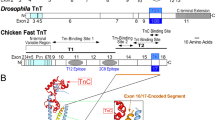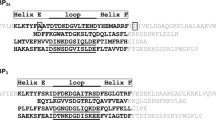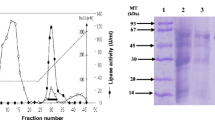Summary
The phospholipase C isoform responsible for the increase in the total myoplasmic inositol 1,4,5-trisphosphate concentration during tetanic contraction of isolated skeletal muscle and its mechanism of activation is not known. We have cloned and sequenced a phospholipase C cDNA of rabbit skeletal muscle coding for a protein of 745 amino acids with a molecular mass of 84 440 kDa. The deduced amino acid sequence exhibits the phospholipase C-specific domains X and Y which according to current knowledge very likely represent the catalytic centre of the enzyme. An overall sequence homology of 88% to the phospholipase C-δ1 of rat brain suggests that the encoded protein represents a phospholipase C-δ1 isoform of rabbit skeletal muscle. Northern blot analysis shows, that this phospholipase C-δ is dominantly expressed in skeletal muscle, less strongly in smooth muscle (uterus) and lung and weakly in heart, kidney and brain. In the N-terminal part of the primary structure a consensus sequence for a canonical EF-hand Ca2+ binding domain can be identified together with a short positively charged motif which recently has been suggested to be essential for the binding of phosphatidylinositol 4,5-bisphosphate. If these two domains which are unique for phospholipase C-δ are sufficient in establishing a mechanism for the activation of the enzyme, inositol 1,4,5-trisphosphate formation in skeletal muscle could be the consequence of an increase in myoplasmic Ca2+.
Similar content being viewed by others
References
BAIROCHA. & COXJ. A. (1990) EF-hand motifs in inositol phospholipid-specific phospholipase C. FEBS Lett. 269, 454–6.
BERRIDGEM. (1993) Inositol trisphosphate and calcium signalling. Nature 361, 315–25.
BLOOMQUISTB. T., SHORTRIDGER. D., SCHNEUWLYS., PERDEWM., MONTELLC., STELLERH., RUBING. & PAKW. L. (1988) Isolation of a putative phospholipase C gene of drosophila, norpA, and its role in phototransduction. Cell 54, 723–33.
BURGOYNER. D. (1994) Phosphoinositides in vesicular traffic. TIBS 19, 54–5.
CARRASCOM. A., SIERRALTAJ. & HIDALGOC. (1993) Phospholipase C activity in membranes and a soluble fraction isolated from frog skeletal muscle. Biochim. Biophys. Acta 1152, 44–8.
CHOMCZYNSKIP. & SACCHIN. (1987) Single-step method of RNA isolation by acid guanidinium thiocyanatephenol-chloroform extraction. Analyt. Biochem. 162, 156–9.
CIFUENTESM. E., DELANEYT. & REBECCHIM. J. (1994) D-myo-inositol 1,4,5-trisphosphate inhibits binding of phospholipase C-delta 1 to bilayer membranes. J. Biol. Chem. 269, 1945–8.
COCKCROFTS. & THOMASG. M. H. (1992) Inositol-lipid-specific phospholipase C isoenzymes and their differential regulation by receptors. Biochem. J. 288, 1–14.
DRAYERA. L. & VANHAASTERTP. J. M. (1992) Molecular cloning and expression of a phosphoinositide-specific phospholipase C of Dictyostelium discoideum. J. Biol. Chem. 267, 18387–92.
DURUSSELI., LUAN-RILLIETY., PETROVAT., TAKAGIT. & COXJ. A. (1993) Cation binding and conformation of tryptic fragments of Nereis sarcoplasmic calcium-binding protein: calcium-induced homo- and heterodimerization. Biochem. 32, 2394–400.
EMORIY., HOMMAY., SORIMACHIH., KAWASAKIH., NAKANISHIO., SUZUKIK. & TAKENAWAT. (1989) A second type of rat phosphoinositide-specific phospholipase C containing a src-related sequence not essential for phosphoinositide-hydrolizing activity. J. Biol. Chem. 264, 21885–90.
HANNONJ. D., LEEN. K.-M., YANDONGC. & BLINKSJ. R. (1992) Inositol trisphosphate (InsP3) causes contraction in skeletal muscle only under artificial conditions: evidence that Ca2+ release can result from depolarization of T-tubules. J. Muscle Res. Cell Motil. 13, 447–56.
HARLANJ. E., HAJDUKP. J., YOONH. S. & FESIKS. W. (1994) Pleckstrin homology domains bind to phosphatidylinositol-4,5-bisphosphate. Nature 371, 168–70.
JAIMOVICHE. (1991) Chemical transmission at the triad: InsP3? J. Muscle Res. Cell Motil. 12, 316–20.
KOZAKM. (1987) An analysis of 5′-noncoding sequences from 699 vertebrate messenger RNAs. Nucleic Acids Res. 15, 8125–48.
KRETSINGERR. H., TOLBERTD., NAKAYAMAS. & PEARSONW. (1991). The EF-hand, homologs and analogs. In: Novel Calcium-Binding Proteins (edited by HEIZMANNC. W.) pp. 17–37. Heidelberg: Springer Verlag.
MAYRG. & THIELECZEKR. (1991) Masses of inositol phosphates in resting and tetanically stimulated vertebrate skeletal muscles. Biochem. J. 280, 631–40.
MELDRUME., KRIZR. W., TOTTYN. & PARKERP. J. (1991) A second gene product of the inositolphóspholipid-specific phospholipase Cδ subclass. Eur. J. Biochem. 196, 159–65.
MILTINGH., HEILMEYERL. M. G.Jr. & THIELECZEKR. (1994) Phosphoinositides in membranes that build up the triads of rabbit skeletal muscle. FEBS Lett. 345, 211–18.
MUSACCIOA., GIBSONT., RICEP., THOMPSONJ. & SARASTEM. (1993) The PH domain: a common piece in the structural pathchwork of signalling proteins. TIBS 18, 343–8.
PAYNEW. E. & FITZGERALD-HAYESM. (1993) A mutation in PLC1, a candidate phosphoinositide-specific phospholipase C gene from Saccharomyces cerevisiae, causes aberrant mitotic chromosome segregation. Mol. Cell. Biol. 13, 4351–64.
PENNERR., NEHERE., TAKESHIMAH., NISHIMURAS. & NUMAS. (1989) Functional expression of the calcium release channel from skeletal muscle ryanodine receptor cDNA. FEBs Lett. 259, 217–21.
RHEES. G. & CHOIK. D. (1992) Regulation of inositol phospholipid-specific phospholipase C isozymes. J. Biol. Chem. 267, 12393–6.
SAMBROOKJ., FRITSCHE. F. & MANIATIST. (1989) Molecular Cloning (Vol. 1–3). Cold Spring Harbor: Laboratory Press.
SHAWG. S., HODGESR. S. & SYKESB. D. (1990) Calcium-induced peptide association to form an intact protein domain: 1H NMR structural evidence. Science 249, 280–3.
SUX., CHENF. & HOKINL. E. (1994) Cloning and expression of a novel, highly truncated phosphoinositid-specific phospholipase C cDNA from embryos of the brine shrimp, Artemia. J. Biol. Chem. 269, 12925–31.
SUHP.-G., RYUS. H., MOONK. H., SUHH. W. & RHEES. G. (1988a) Cloning and sequence of multiple forms of phospholipase C. Cell 54, 161–9.
SUHP.-G., RYUS. H., MOONK. H., SUHH. W. & RHEES. G. (1988b) Inositol phospholipid-specific phospholipase C: complete cDNA and protein sequences and sequence homology to tyrosine kinase-related oncogene products. Proc. Natl Acad. Sci. USA 85, 5419–23.
THIELECZEKR., MAYRG. W. & BRANDTN. R. (1989) Inositol polyphosphate-mediated repartitioning of aldolase in skeletal muscle triads and myofibrils. J. Biol. Chem. 264, 7349–56.
VARSÁNYIM., MESSERM. & BRANDTN. R. (1989) Intracellular localization of inositol-phospholipid-metabolizing enzymes in rabbit fast-twitch skeletal muscle. Eur. J. Biochem. 179, 473–9.
YAGISAWAH., HIRATAM., KANEMATSUT., WATANABEY., OZAKIS., SAKUMAK., TANAKAH., YABUTAN., KAMATAH., HIRATAH. & NOJIMAH. (1994) Expression and characterization of an inositol 1,4,5-trisphosphate binding domain of phosphatidylinositol-specific phospholipase C-δ1. J. Biol. Chem. 269, 20179–88.
YOKO-OT., MATSUIY., YAGISAWAH., NOJIMAH. & UNOI. (1993) The putative phosphoinositide-specific phospholipase C gene, PLC1, of the yeast Saccharomyces cerevisiae is important for cell growth. Proc. Natl Acad. Sci. USA 90, 1804–8.
YUF.-X., SUNH.-Q., JANMEYP. A. & YINH. L. (1992) Identification of a polyphosphoinositide-binding sequence in an actin monomer-binding domain of gelsolin. J. Biol. Chem. 267, 14616–21.
Author information
Authors and Affiliations
Rights and permissions
About this article
Cite this article
Milting, H., Heilmeyer, L.M.G. & Thieleczek, R. Cloning of a phospholipase C-δ1 of rabbit skeletal muscle. J Muscle Res Cell Motil 17, 79–84 (1996). https://doi.org/10.1007/BF00140326
Received:
Accepted:
Issue Date:
DOI: https://doi.org/10.1007/BF00140326




